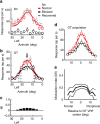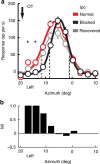Spatially precise visual gain control mediated by a cholinergic circuit in the midbrain attention network
- PMID: 27853140
- PMCID: PMC5118544
- DOI: 10.1038/ncomms13472
Spatially precise visual gain control mediated by a cholinergic circuit in the midbrain attention network
Abstract
A primary function of the midbrain stimulus selection network is to compute the highest-priority location for attention and gaze. Here we report the contribution of a specific cholinergic circuit to this computation. We functionally disconnected the tegmental cholinergic nucleus isthmi pars parvocellularis (Ipc) from the optic tectum (OT) in barn owls by reversibly blocking excitatory transmission in the Ipc. Focal blockade in the Ipc decreases the gain and spatial discrimination of OT units specifically for the locations represented by the visual receptive fields (VRFs) of the disconnected Ipc units, and causes OT VRFs to shift away from that location. The results demonstrate mechanisms by which this cholinergic circuit controls bottom-up stimulus competition and by which top-down signals can bias this competition, and they establish causal linkages between a particular circuit, gain control and dynamic shifts of VRFs. This circuit may perform the same function in all vertebrate species.
Figures








References
-
- Tolias A. S. et al.. Eye movements modulate visual receptive fields of V4 neurons. Neuron 29, 757–767 (2001). - PubMed
-
- Moran J. & Desimone R. Selective attention gates visual processing in the extrastriate cortex. Science 229, 782–784 (1985). - PubMed
-
- Armstrong K. M., Fitzgerald J. F. & Moore T. Changes in visual receptive fields with microstimulation of frontal cortex. Neuron 50, 791–798 (2006). - PubMed
Publication types
MeSH terms
Substances
Grants and funding
LinkOut - more resources
Full Text Sources
Other Literature Sources
Miscellaneous

